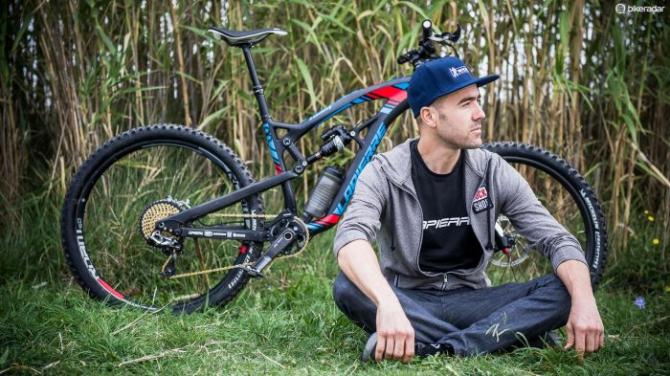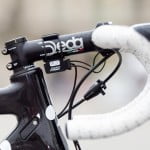It’s fair to say the words Nicolas Vouilloz and legend go hand in hand. With 10 world champion downhill titles and numerous individual wins – in everything from the Enduro World Series racing to rally car driving – under his belt, his talent is undeniable. But it’s his attention to detail, too, that’s always set him apart.
It’s not surprising then that Vouilloz’s new 2016 Lapierre Spicy Team enduro bike is a treasure trove of technical trickery, with every single detail meticulously thought out and a whole host of tweaks present and correct to perfect it to his needs. Indeed, when I try to corner him at the Roc d’Azur so we can chat about his bike, I think I’ve been stood up – only to discover him the workshop, making sure every part of the bike is utterly clean before any photos are taken.
Devil’s in the development
Vouilloz has a very different status to Lapierre’s other pro riders, because he’s actually a paid member of the R&D team. Along with the product managers and engineers he’s intimately involved in the development of all of Lapierre’s mountain bikes, with the reputation of being (wait for it) something of a perfectionist.
The story started over a year ago when Vouilloz began riding a specially modified version of the 2015 Spicy in order to experiment with both geometry and travel. However, these modifications to the old bike had a few side effects…
“It was pedalling well, but not as well as it could,” Vouilloz tells BikeRadar. “[The new bike] has more travel and it’s pedalling like the old Spicy in 150mm, and I can ride a bigger ring. The bike is made for 34t to be the best efficiency. In the past the Spicy was made more for 30-32t but now it’s a bit more for racing.”

Nico Vouilloz is more than just a team rider for Lapierre. he’s a salaried member of the brand’s R&D team
Suspension travel now up to 165mm over the 150mm on the old bike too, with a focus on a more progressive stroke, which Vouilloz says helps the bike keep speed. This means a less ‘plush’ feeling – and he reckons it’s a little less comfortable on rock gardens, but says it’s worth in in terms of overall gain.
Getting the fit right
While Vouilloz used to ride a large-size in the 2015 bike, the reach numbers for the new model have been increased and he now rides a medium, which at 444mm is a better match for his 5ft 9in (175cm) frame. He runs a Truvativ BlackBox carbon bar that’s 750mm wide and has a 20mm rise, but he’s added nylon end plugs to bump that actual width to 770mm.

See that white bit at the end of the bar? it’s a nylon plug that boosts the width to 770mm
That’s paired with a 45mm stem, something Vouilloz settled on only after testing both longer and shorter items.
Related: The adjustable mountain bike stem is here, and we’re not sure we need it
“50mm is a bit long; 40mm is a bit short,” he explains. “The longer the stem is when it’s straight and fast, the more stable the bike. Honestly, it’s crazy the difference it makes. I was riding 30mm and it’s nice if it’s steep but on the fast stuff it’s feeling not so confident – I needed to improve the level of the bike. You put 60mm on and it’s much more stable in a straight line.”

Vouilloz settled on a 45mm stem to balance stability at speed with performance on steep terrain
When it comes to front end height, that’s also the result of more painstaking testing.
“I work a lot also on the height and it depends on the bottom bracket height and feeling. I try to be as low as possible for the grip, but not too low for steep parts,” Vouilloz goes on. “It’s always a compromise, but yeah, if something is not just there, I try – every time.”
Special-recipe suspension
The Spicy Team comes fitted with Lapierre’s E:I system, which automatically adjusts the rear shock settings based on both cadence and terrain inputs.It’s only currently available on inline RockShox Monarch shocks, but Nico has the system rigged up to a Monarch Plus shock. The main reason for this is that the piggyback design transfers less heat from the damping oil to the air in the can, keeping the pressure more consistent over a long run.
“When you have inline shocks you say, ‘Yeah, okay, I like 35 percent sag’ then you have to start at 40 percent and finish [a stage] at 25 percent,” says Vouilloz. “With this, you start at 35 percent, you finish at 32 percent.”

A specially rigged E:I motor is fitted to a Monarch Plus piggyback shock rather than the inline Monarch of stock bikes
Vouilloz alters the amount of sag at the rear depending on how pedally or rough the track is, using stiffer settings on flatter tracks. While the shock has the stock rebound tune, after much experimenting though the season, he’s arrived at compression tune that he’s happy with. It uses the same piston, but the shim stack is a little different to what you or I might use.
“I worked on the compression with RockShox – it’s really adjusted for my weight. It has to be good. It’s made for fast guys! When you hit rocks fast you maybe need less hydraulic and especially high speed than normal, because if not you can break wheels and things because they won’t absorb [the impact].”
Even Vouilloz isn’t infallible though, having to alter settings derived on home turf to suit the more varied tracks of the EWS, with the first round of the season in Scotland’s Tweed Valley proving a rude awakening.
“The main thing that’s hard with it is that during the winter you work using the trails where you ride and are used to riding,” Vouilloz says. “I arrived in Scotland and was not happy with the results [of my setup]. You need a lot of knowledge and different tracks for an enduro bike to really work all-round.”

The E:I system is powered by a much smaller and lighter unit, mounted under the bb, than on consumer bikes
The E:I system has also been slightly modified, with the control unit moved from its usual position on the stem cap and instead attached to the head tube using Velcro to keep it out of harm’s way. It’s powered by a small, lightweight battery pack mounted under the bottom bracket rather than the bottle cage bosses, freeing them up for a Fabric Cageless bottle.

The E:I control unit is Velcroed to the head tube instead of being mounted on the steerer, keeping it out of danger and aiding quick removal
Waxing Lyrikal
Unlike production Team bikes, which use a 160mm travel RockShox Pike, Vouilloz is running a RockShox Lyrik with 170mm of travel. He reckons that 150g of extra weight this adds is well worth it, as it feels like a much bigger, more stable fork.
It’s also slacked out with the addition of 1-degree offset head cups, taking the head angle to somewhere slightly south of 65 degrees. Vouilloz tends to go for a lightly sagged setup and also to run the fork with as little hydraulic damping force as possible. That means a minimum of three and sometimes four volume spacers inside the Solo Air spring to give good support. While previously he was running more rear shock sag to give a slacker head angle, this setup enables him to keep the slack head angle without doing that. It’s not something he changes for individual races either.

A 170mm-travel RockShox Lyrik weighs 150g more than the standard fit 160mm Pike
“When it’s steep and rough – it depends if the stage looks like a downhill – it’s good to have downhill geometry,” Vouilloz goes on. “After, the problem is that you come home and you do uphills and downhills, your bike is a bit slow and sometimes not so fun, because it’s too extreme!”
While the Lyrik can accept SRAM’s larger diameter Predictive Steering hub interface, Vouilloz was running a standard item. Even the world’s best riders are at the mercy of supply sometimes – he simply hadn’t received a new hub in time for the race season. He’s also switched the 15mm quick-release Maxle thru-axle for a lighter bolt-up axle, and it’s the same story at the rear of the bike. While this takes longer to change a wheel in the event of a puncture, Vouilloz is more concerned with real-world race use.
“If you flat you’re dead, dead for dead! These are lighter and nicer,” he says. “I don’t think you can change [a puncture] during a stage, it’s better to go through the stage, cross the finish and hope you didn’t break the wheel.”
Custom rubber
Vouilloz runs Michelin tyres and as you’d expect, these aren’t off-the-shelf items either. Both the ‘Prototype’ logoed front Wild Grip’R and Wild Race’R Enduro rear have special compounds, with ridiculously soft and sticky edge tread matched to a much harder centre to maximise corner grip while dropping rolling resistance. They’re run tubeless, with Effetto Mariposa Caffelatex foaming sealant inside.

Michelin tyres get special prototype compounds
When the subject of Schwalbe’s dual-chamber ProCore setup (which involves running a small high-pressure inner tube within tubeless rubber) is mentioned, Vouilloz says he’s hasn’t tried the system but may well test it during the winter. Based on what he’s seen with other riders so far, he’s not entirely convinced.
“I think it works but it’s not like a revolution. I’m not sure in any case that you can ride a lighter tyre. Maybe you have ProCore and it’s easier to ride if you flat but it [won’t allow] a lighter tyre.”
Survivalist wheels

Vouilloz is also running an interesting wheel setup, using an alloy SRAM Roam 50 rim at the rear and a prototype 30mm wide SRAM BlackBox carbon item up front. While the wider rim up front gives the tyre a better edge profile and allows lower pressures, at the rear it comes back to the question of race day survivability.
An alloy rim is more likely to bend than snap if it takes a seriously hard impact, and while he tested using a 30mm wide alloy prototype Vouilloz found the increased width made it too stiff, increasing the chances of a puncture – especially if run with less pressure in the tyre. While he feels the advances he’s made with suspension setup may now allow him to use the new carbon item on the rear, it’s not something he wanted to chance mid-season.
The narrow 21mm internal width of the Roam also gives a more rounded profile to the rear tyre, ensuring that it’s the harder centre tread and not the super sticky edges that contact the ground, reducing rolling resistance.
Going for gold

Elsewhere, the SRAM X01 drivetrain’s chain and cassette have been given a ceramic titanium nitride coating as part of SRAM’s BlackBox athlete program, which results in a blinged-out gold look but also hugely increased wear resistance.
Chain security is boosted by a Truvativ-branded MRP chain guide, which has had the lower bashguard removed and has been given the Dremel treatment to lose weight from the aluminium backing plate.
Vouilloz runs a 125mm drop RockShox Reverb instead of a longer 150mm item, as he finds that the latter drops too low and can increase fatigue, though this is something he says he plans to experiment with. On top of the seatpost is perched a carbon-railed Fabric Scoop Flat Pro saddle, something that’s lightweight but comfortable on long days of riding.

The final personal touches are the enduro motorbike-style hand defenders. They’re made by a friend of Vouilloz’s and help prevent a knucklefull of thorns on his spiky local trails. At 100g there’s only a minor weight penalty and, usefully for someone that’s suffered a number of hand injuries, the guards will clip obstacles without his hands striking to give a useful early warning that he’s pushing too hard.
[“source-cyclingnews”]





